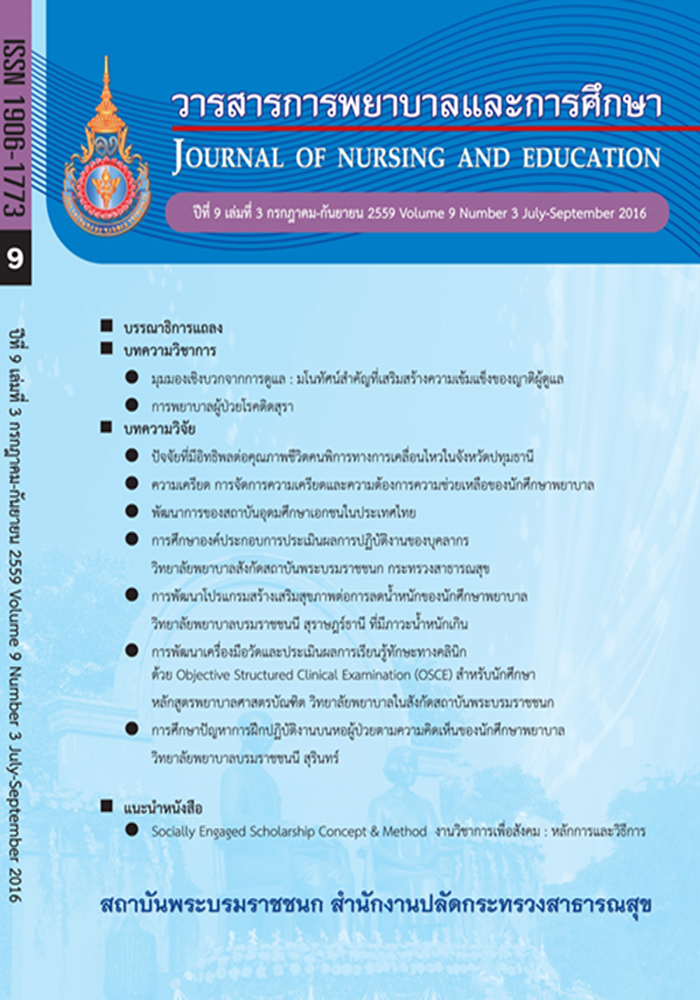ความเครียด การจัดการความเครียดและความต้องการความช่วยเหลือของนักศึกษาพยาบาล
คำสำคัญ:
ความเครียด, สาเหตุของความเครียด, การจัดการความเครียด, ความต้องการความช่วยเหลือ, นักศึกษาพยาบาล, stress, causes of stress, stress management, need to supports, nursing studentsบทคัดย่อ
การวิจัยเชิงบรรยายนี้มีวัตถุประสงค์ 3 ประการคือ 1) ศึกษาดับความเครียด สาเหตุของความเครียด วิธีการจัดการความเครียด และความต้องการความช่วยเหลือของนักศึกษาพยาบาลเมื่อมีความเครียด 2) เปรียบเทียบความเครียดและการจัดการความเครียดของนักศึกษาแต่ละชั้นปี และ 3) หาความสัมพันธ์ระหว่างความเครียดและการจัดการความเครียด กลุ่มตัวอย่างคือนักศึกษาพยาบาลที่กำลังศึกษาในหลักสูตรพยาบาลศาสตรบัณฑิต สถาบันแห่งหนึ่งในภาคใต้ของประเทศไทย ปีการศึกษา 2558 จำนวน 306 คน กลุ่มตัวอย่างเลือกแบบเฉพาะเจาะจง เครื่องมือที่ใช้ในการวิจัยเป็นแบบสอบถามที่มีค่าความเชื่อมั่นระหว่าง 0.85 – 0.94 วิเคราะห์ข้อมูลเชิงปริมาณโดยใช้สถิติเชิงพรรณนา one way ANOVA และ Pearson’s Correlation coefficient ข้อมูลเชิงคุณภาพวิเคราะห์โดยการวิเคราะห์เนื้อหาและแจกแจงความถี่
ผลการศึกษา: พบว่าครึ่งหนึ่งของนักศึกษาพยาบาลมีความเครียดอยู่ในระดับสูง (ร้อยละ 50.7) สาเหตุของความเครียดมาจากกิจกกรมด้านการเรียนทั้งหมด ส่วนมากใช้วิธีการจัดการความเครียดทั้ง 3 วิธีในระดับปานกลาง (ร้อยละ 91.8) คะแนนเฉลี่ยความเครียดและการจัดการความเครียดของนักศึกษาแต่ละชั้นปีพบว่าไม่แตกต่างกัน (p>.05) เช่นเดียวกับความสัมพันธ์ระหว่างความเครียดและการจัดการความเครียดพบว่าไม่มีความสัมพันธ์กัน (p>.05) ความต้องการความช่วยเหลือเมื่อมีความเครียด พบว่าห้าลำดับแรกที่นักศึกษาต้องการความช่วยเหลือได้แก่ ครอบครัว (ร้อยละ 59.47) ครอบครัว (ร้อยละ 32.02) เพื่อน (ร้อยละ 23.20) อาจารย์ (ร้อยละ 17.64) และ อาจารย์ (ร้อยละ 12.09 )
สรุปผลการศึกษา: ผลการศึกษาจะช่วยให้สถาบันการศึกษาพยาบาลมีความเข้าใจและเพิ่มความตระหนักในประเด็นความเครียด สาเหตุ การจัดการและความต้องการความช่วยเหลือของนักศึกษาพยาบาลเมื่อมีความเครียดรวมทั้งการเตรียมการเพื่อให้ความช่วยเหลือและส่งเสริมสุขภาพจิตที่ดีและคุณภาพการเรียนรู้ในหลักสูตรของนักศึกษาพยาบาลต่อไป
Stress, Causes of Stress, Stress Management and the Need to Supports Nursing Students
This descriptive research has three objectives: first, to examine stress, the causes of stress, stress management and the need to support nursing students when suffering stress; second, to compare stress and the management of stress of nursing students of each different year of studies; and, third, to analyze the relationship between stress and stress management methods of nursing students.
Method: The sample group consisted of 306 nursing students studying in the undergraduate program of a school of nursing in Southern Thailand in 2015. The sample group was selected using the purposive sampling method. The research tool employed was a questionnaire using Cronbach’s alpha coefficient yielding reliability values between 0.85 – 0.94. Descriptive statistics, one way ANOVA and Pearson’s Correlation coefficient were used to analyze the quantitative data. At the same time, content analysis and frequency count were utilized to analyze the qualitative data.
Results: The results indicated that about half of the nursing students experienced stress at a high level (50.7 percent) and most of them had stress due to learning activities. A majority of these nursing students used three methods in stress management at a moderate level (91.8 percent). No significant differences (p >.05) were found between the mean of stress and stress management methods among students in the four different years of study. Also, the relationship of stress and stress management of nursing students were found not to be significantly correlated (p < .05). The top five ranked sources of support needed by nursing students were found that the first rank was their family (72.22 %), the second was also their family (38.89 %), the third rank was friends (30.34 %), the fourth rank was instructors (26.34 %), and the fifth rank was instructors (22.03%).
Conclusion: The findings could help raise the awareness of nursing education institutions in understanding student nurses’ stress, causes of stress, methods of dealing with stress and their sources of support when undergoing stress in order to be prepared to assist and promote healthy mental health that would further enhance the quality of learning in the nursing program.






